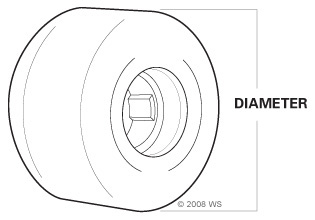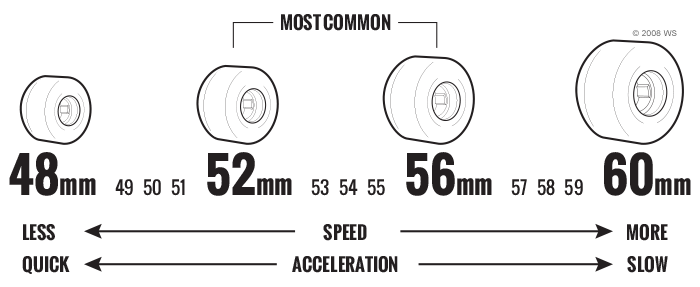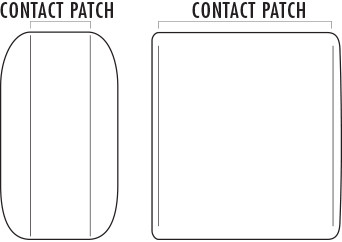What’s the right size skateboard wheel for you?
Simply put, the skateboard wheels are the part of your skateboard that allows you to move and help determine how fast you can go. Typically made of polyurethane, skateboard wheels come in a range of sizes, colors, and durability levels to suit your skateboard style and preference.
Skateboard wheels are measured by both diameter and durometer. The diameter is the size of the wheel, and the durometer is the hardness of the wheel. Both of these factors are a matter of personal preference, and what you intend to do on your skateboard. Custom building allows you to choose what the best wheels are to match your deck, trucks, and hardware.
Choosing a skateboard wheel size (diameter)

Skateboard wheel diameter is measured in millimeters (mm); most wheels range from 50-75 mm, and the lower the number, the smaller the wheel.
Wheel diameter also affects how quickly you accelerate and how tightly you can turn. Smaller wheels result in a slower ride, whereas larger wheels result in a faster one. And because they’re lower to the ground and typically easier to control, smaller wheels are ideal for technical or street skating. If you’re a beginner or someone who uses a skateboard as daily transportation, you’ll want to look into larger wheels instead. Their increased diameters offer speed and balance all in one, making them perfect for low-key cruising or vert skating.
Additionally, your height and weight can affect what size wheels feels right for you.
| 50-53mm | Small, slower wheels; stable for trick riding and smaller riders skating street, skate parks, and bowls. |
| 54-59mm | Average wheel size for beginners and bigger riders skating street, skate parks, bowls, and vert ramps. |
| 60mm + | Specialty riders skating longboards, old-school boards, downhill, and dirt boards; made for speed and rougher surfaces. |

In addition to size variations, skateboard wheels also come in different shapes, or cuts, including narrow or wide lip, and cruiser wheel shape. If you’re looking for a ride with less friction and weight, the narrow lip wheels are the way to go, and can help you master that next trick because they’re much more responsive to quick movements. Conversely, beginners and commuters will be more likely to invest in cruiser wheels because they tend to have the best grip as well as rounded outer lips. But, if you’d like an option that includes the best of both worlds, consider standard wide lip wheels; though less inclined for speed than the narrower models, these are sturdy and balanced, making them an asset to the average skater both around the skate park or on the street.
Choosing a skateboard wheel hardness (durometer)
Durometer measures the skateboard wheel’s hardness, which can in turn specify if that particular wheel is better suited for skateboards or longboards. Most manufacturers use the Durometer A Scale, which is a 100-point scale that quantifies how hard a wheel is. The higher the number, the harder the wheel, although the average wheel durometer is 99a.
There are some manufacturers that may instead use the B Scale, which measures 20 points fewer than the A Scale, and therefore allows for an extra 20 points for the hardest wheels. For example, an 80b durometer is the same hardness as a 100a durometer. These skateboard wheels have a wider and more accurate hardness range.
Some brands will also experiment with dual-durometer wheels for a more tailored skating experience. In the case of a dual-durometer skateboard wheel, the inside of the wheel could measure one standard of hardness, while the outside of the wheel is another. This practice often allows for more speed and durability in your skateboard wheels, since it gives them a combination of strengths from both ends of the measurement’s spectrum.
Generally speaking, harder wheels are faster, and softer wheels are slower with the added advantage of having more grip. Softer wheels are better suited to street skating; harder wheels are better for smooth surfaces, such as skate parks. Some companies even specially design their wheels for a specific use. For instance, Bones STF Formula and Spitfire F1 Street Burners are designed specifically for street terrain, while Bones SPF Formula and Spitfire F1 Park Burners are designed for park terrain.
Here are some general guidelines for wheel durometer as it concerns your skating preferences and skill level.

| 78a-87a | Soft wheel good for rough surfaces, longboards, or street boards that need lots of grip to easily roll over cracks and pebbles. Designed for smooth rides, cruising, longboards, hills, and rough surfaces. |
| 88a-95a | Slightly harder and faster with a little less grip, but the grip’s still good. Good for street and rough surfaces. |
| 96a-99a | Nice speed and grip– an all-around good wheel. Great for beginners skating street, skate parks, ramps, pools, and other smooth surfaces. |
| 101a + | Hardest and fastest wheel with the least grip. Ineffective on slick and rough surfaces. These are pro wheels. |
| 83b-84b | Wheels using the B scale are extremely hard, measuring 20 points fewer than the A Scale in order to allow the scale to extend another 20 points for the hardest wheels. |

Choosing a skateboard wheel shape & contact patch
Contact patch is an important feature of skateboard wheel performance. A wheel’s contact patch refers to the area of the wheel that actually makes contact with the pavement. If you have large longboard wheels, your contact patch will also be large.
So why is contact patch important? If you have a large contact patch, your weight will be distributed over a larger area. This reduces the compression of the urethane in your wheels and decreases rolling resistance, which can slow down your wheel.
Wheel shape affects the size of your contact patch as well. Rounded wheels make less contact with the pavement, while square wheels make maximum contact with pavement. The placement of contact patches can also affect wheel performance.
